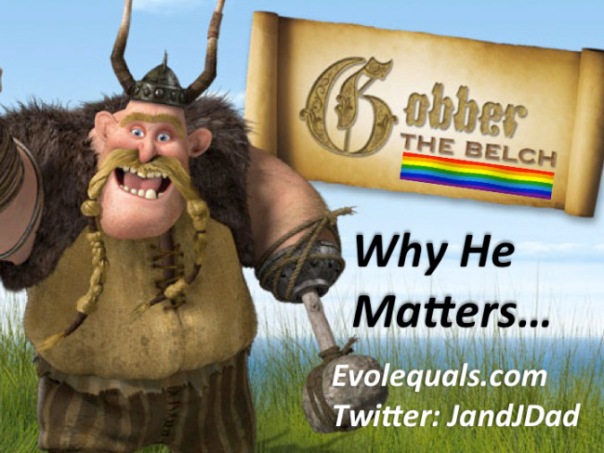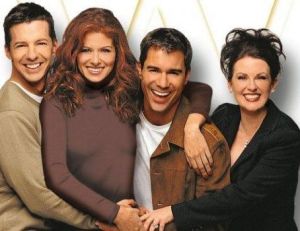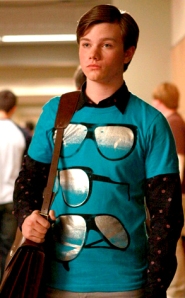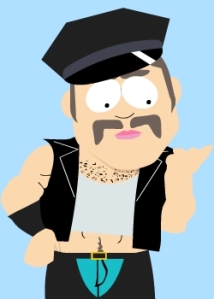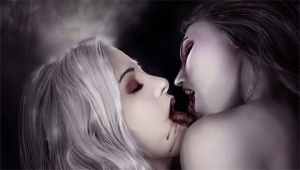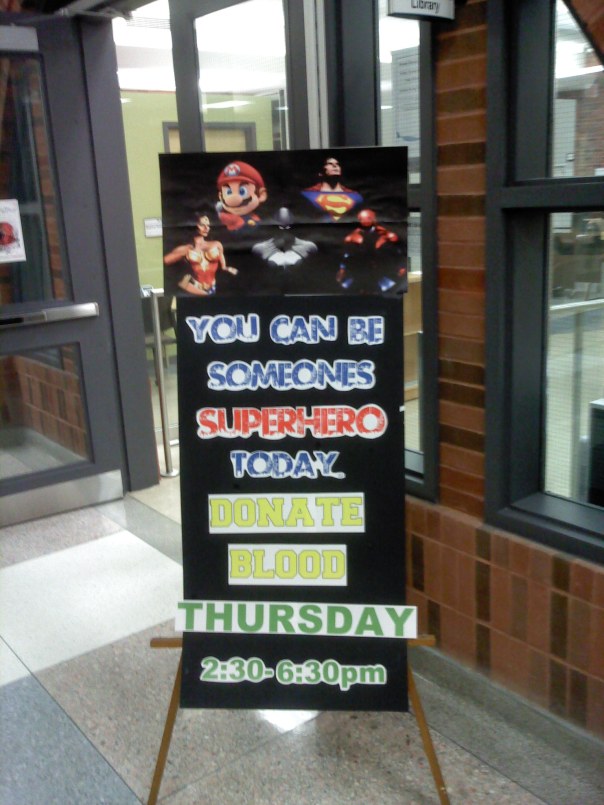How My Eleven Year Old Son Taught Me That Having a Gay Character in ‘Train Your Dragon’ is Important
Guest post by Mindy Forsythe. Mindy is also the adoptive mom in the evolequals story The Real True Story About How Parents Adopted Out Their Child When He Told Them He Was Gay
My eleven year old son Mason has been a big fan of DreamWork’s “How to Train Your Dragon”. In the new sequel, DreamWorks plans for Gobber the Belch to reveal his homosexuality. Dean DeBlois, writer-director and openly gay himself, told E! News that the character’s acknowledgement will be subtle. Subtle or not, this is exciting news for our family. We have four beautiful children aged eleven to nineteen. They are typical siblings…fighting one minute and best friends the next. Two of our children, however, have a relationship that has shown me just how important and influential DreamWorks’s decision to include gay characters really is.
Mason, the baby in our family, is athletic, intelligent, tough as nails…
View original post 1,244 more words
Something I simply had to pass on…
I came across this essay by a great social critic and I simply couldn’t resist posting it here. If you want to read the original and more like it, then go to this link: http://johnshore.com/2010/10/01/how-is-being-gay-like-gluing-wings-on-a-pig/
Now, here’s a fantastic essay:
“Wings on a Pig
by John Shore on October 1, 2010 in Christian Issues · 885 comments
These days, every Christian who is “against homosexuality” (whatever in the name of Monstro’s blowhole that actually means) presents the same argument. That argument is … well, this, taken directly from an email sent me this morning:
Would you support a serial adulterer who loves his wife, but is just attracted to other women because that’s who he is and how he was born? How about an alcoholic who just can’t help himself? Would you support him as he leaves his wife for alcohol? A glutton? A man of extreme pride? Why does homosexuality get a pass, and not any other sin? A person with homosexual desires who resists temptation is exactly the same as a married man who resists temptation to carry on affairs with other women — which is to say, a human being battling the temptation to sin. The most compassionate thing that we could tell someone struggling with homosexuality (or any other sin for that matter) is to keep resisting temptation. Keep battling. Don’t give in. This is your badge as a Christian, that you fight temptation.
Um … for the record, I do not make this stuff up.
By “these days,” I mean that the typical Christian argument against homosexuality has changed. It used to be, “Gays are really only messed-up straight people. They should let Jesus make them straight, so that they can stop acting all gay and not go to hell.”
Nowadays the Christian refrain isn’t, “Stop being gay.” Now it’s “Stop acting gay.” They’ve given up trying to argue that gays can change their sexual orientation: the complete failure of Christian Fix-a-Gay and Homo No’ Mo! programs — not to mention a universe of anecdotal and empirical evidence — have left them little choice in that.
So they’ve changed their approach. Now their argument is that a homosexual struggling against the temptation to act homosexual is no different from anyone else struggling to resist a “sinful” temptation.
Christians love this new argument. If I’ve heard it once I’ve heard it ten thousand times. We all have. You whisper “gay” into the ear of a sleeping Christian, and there’s an excellent chance they’ll just start saying it in their sleep. “Just like any other sinful temptation. We’re all sinners. Must resist.”
And putting your brain to sleep before you say that is the very best way to say it, too. Because it could only make sense to a brain-dead person. It’s just too stupid for words.
But lemme try to find some words anyway.
Virtually all sins share a crucial, defining, common quality. Because that quality, which is present in every other imaginable sin, is utterly missing from being or acting gay, insisting on putting homosexuality into the same category as every other sin — or in the category of sin at all — is like gluing wings on a pig, and insisting the result belongs in the category of “bird.” It doesn’t. It can’t. It won’t. Ever.
Here is that Big Difference between homosexuality and all those activities generally understood to be “sinful”: There is no sin I can commit that, by virtue of committing it, renders me incapable of loving or being loved. I can commit murder. I can steal. I can rob. I can rape. I can drink myself to death. I can do any terrible thing at all — and no one would ever claim that intrinsic to the condition that gave rise to my doing that terrible thing is that I am, by nature, simply incapable of giving or receiving love.
No one tells the chronic drinker, or glutton, or adulterer, or any other kind of sinner, to stop experiencing love. Yet that’s exactly what so many Christians are insisting that gay people do.
When you tell a gay person to “resist” being gay, what you are really telling them — what you really mean — is for them to be celibate.
What you are truly and actually saying is that you want them to condemn themselves to a life devoid of the kind of enduring, romantic, partner-to-partner love that all people, Christians included, understand as just about the best part of being alive.
Be alone, you’re demanding. Live alone. Don’t hold anyone’s hand. Don’t snuggle on your couch with anyone. Don’t cuddle up with anyone at night before you fall asleep. Don’t have anyone to chat with over coffee in the morning.
Do not bind your life to that of another. Live your whole life without knowing that joy, that sharing, that peace.
Just say “no” to love.
Be alone. Live alone. Die alone.
The “sinful temptation” that Christians are forever urging LGBT people to resist is love.
Being, of course, the one thing Jesus was most clear about wanting his followers to extend to others.”
I simply have one thing to say: Thank you. It’s great to see someone like you standing up for someone like me. We could always use more people like you in the world.
In Conclusion…
None of the portrayals mentioned in previous posts are perfect portrayals nor are they perfect stereotypes and, in a way, that makes it all a little better because the queer community is incredibly diverse and incredibly varied and portraying any queer character as perfect would only create another flawed perception. Everyone has their flaws, even queer people, and so none of the queer stereotypes is necessarily bad on its own, but it is when they are all people see that they become a problem because they limit the kinds of narratives that can be told about queer people.
Some will question the need for more queer narratives because they say, “Well, they’re gay! They won’t appeal to normal people,” and therein lies the problem. I’m gay and I read straight books and watch straight TV and listen to straight music, it’s not weird or gross when I read or watch or hear about a straight couple having sex. Why is it so strange then for a straight person to watch, read or listen to queer narratives?
But, I believe that the most damaging portrayal of all is one that perhaps people don’t even realize is going on, it is that queer people never seem to have happy endings.
There is a quote from Shrek 2 that is oddly appropriate for this final thought:
Let’s see…
P-p-p-p-p, Princess.
Cinderella… Handsome prince, lived happily ever after…
oh, no ogres!
Sleeping Beauty…
handsome prince, no ogres.
Thumbelina, no! Handsel and Gretel, no!
The Golden Bird, the Little Mermaid, Pretty Woman… no, no, no, no, NO!
You see, ogres don’t live happily ever after.
-Fairy Godmother
Look back at this quote and replace the word “ogres” with “queer people”, “gays”, “lesbians”, whatever you want and the quote takes on a lot of poignancy. And, come to think of it, the Shrek series is a queer narrative, it is about someone who does not fit into any of the roles that are laid out in his society and, for a while, he accepts that, but eventually he realizes that he can and should have his own happy ending and, when it is denied to him, he decides to take it.
Because what these portrayals teach queer youth, and queer individuals in general for that matter, is that they are not normal, that they are a mistake, that they are a threat to everything and everyone around them, that they should be normal, they should be straight, that they need to conform to what straight society says they should be and that they do not deserve happy endings because happy endings are reserved only for normal people.
If you want to see more example of queer stereotypes in the media, watch the video below, it does a better job that I ever could (the ending always gets me).
And check out this blog post, it looks provides examples of stereotypes in literature and covers a couple that I did not approach.
http://slckismet.blogspot.ca/2011/06/please-avoid-these-gay-stereotypes-in.html
What I see many of these stereotypes as is what I call, the new minstrelsy. Minstrelsy is a movement that originated during the American Reconstruction, after the Civil War, where white performers would wear blackface and satirize and poke fun at black culture, an example being “Uncle Tom’s Cabin” or the Jim Crow character. Now, I’m not saying that the old minstrelsy has gone away, by any means, but what I am saying is that this genre has been expanded to include queer individuals. What this stereotypes do is poke fun and satirize queer culture and queer identity and an argument could be made that this is a way to push down queer culture in the wake of the numerous leaps forward that have been made in the fight for the queer community to be legitimatize, just as the “old minstrelsy” was an attempt to push down black culture in the wake of African Americans gaining their freedom from slavery. It could even be said that the straight actors who portray these satirized queer characters are wearing a kind of “gayface”. All of these stereotypes rob the queer community of cultural capital and it is important to recognize the threat that these portrayals display and an attempt needs to be made to round out the portrayals with some more positive displays because that will be the only way for queer individuals to truly have their voice heard and to be final and truly integrated into mainstream society.
And, as one final word, a young woman in my class said something that has stuck will me and something I think everyone in mainstream society should think about:
“What do you do when none of the stories are written about you?”
Queer People as Heterosexual
The final popular portrayal of queer individuals is that they are not really gay at all, that they can be straight if they really want to or if society pushes enough or if they pray hard enough, etc. In popular culture, the one show that has illustrated this portrayal more than any other is the NBC show, Will & Grace.
Firstly, look at the title, Will & Grace. It’s not Will & Jack or Karen & Grace, it’s the gay guy and the “fag hag” if I may use that expression. The show, from its very first episode, illustrates that the singular relationship that will be displayed will be between a man and a woman.
As Marisa Connolly points out in the study she conducts on the topic, it “has been clear since the show’s first season that the most important relationship has been the friendship between Will and Grace. Though the program is about a homosexual male and his heterosexual best friend, scripts and comic devices have often made it seem that Will and Grace were the perfect heterosexual couple, separated only by sexual orientation… a plot line that puts off the match up of the leading male and female characters in order to keep the audience tuning in on a weekly basis. Will and Grace are often positioned as a couple, as well as subject to the barbs of Karen, who often chides their bickering or displays of affection with lines like ‘Oh, just climb on top of each other and get it over with already!’” (Homosexuality 7).
Even other characters in the show note the strong, quasiromantic relationship between Will and Grace. I believe even at one point that the two were planning on having a child together. Not only that, but Will’s more masculine portrayal is counterbalanced by Jack, who is probably one of the best examples of the homosexual performance that has been shown on mainstream television.
But, it isn’t just gay men who have had to labour under this portrayal, not even close. Lesbians and queer women have had to endure this portray longer than anyone else and have had to work the hardest to escape from it. The portrayal of lesbians in mainstream media has always been playing into the typical male fantasy of being with two women at the same time and it can be seen that this is a rather badly veiled attempt by screenwriting, producers and directors to draw in a male audience.
Tricia Jenkins, in her analysis of lesbian heterosexualization in teen films states “it is essential to realize that most (if not all) of the mainstream teen films that include lesbian sexuality do not portray those women as traditionally lesbian. For example, Kelly Van Ryan and Susie Toller in Wild Things, Cecile Caldwell and Kathryn Merteuil in Cruel Intentions, and Merteuil’s parody, Katherine Wyler, in Not Another Teen Movie, are all sexually interested in both men and women, and the two friends in American Pie 2, Amber and Danielle, only pretend to be lesbians in order to teach the male cast a lesson in assumptions. While all of these characters appear comfortable engaging in lesbian sexual practices, none of them is exclusively interested in the homosexual lifestyle” (Potential Lesbians 492).
What these portrayals really are is a watering down of queer identity, a softening so that they can appeal to the mainstream public. The problem, therefore, that arises is that homosexuality becomes viewed as something that does not really exist or is something that someone can just slip in and out of when they need to and this is why this is, perhaps, the most damning and damaging portrayal of them all, because it makes it seem like there is no such thing as homosexuality or queer identity.
Like their portrayal as corruptors, this portray leaves queer people with only the capital that comes from being noticed, but it robs them of their voice because everyone sees them as people who are merely pretending, playing for attention or people who do not have a legitimate cause. In effect, this is the worst of the three portrayal described because it does the one thing that neither of the others does, it takes away their narratives. Even as the corruptors, the queer community still has their narratives which others, how ever few, will still listen to, but no one will listen to someone whose narratives they believe are false.
This is cruelest thing that can happen to a disenfranchised group, to rob them of their narratives and their stories is to take away the most precious thing to them because it is the story of their lives and of who they are. By taking that from them, you take away everything that they are and make them nothing…but, perhaps that is the point.
Works Cited:
-Connolly, Marisa. Homosexuality on Television: The Heterosexualization of Will & Grace in the Media. Georgetown University. 2003. Retrieved 20 Nov. 2012. Online.
-Jenkins, Tricia. “Potential Lesbians at Two O’Clock”: The Heterosexualation of Lesbianism in the Recent Teen Film. Journal of Popular Culture. Retrieved 20 Nov. 2012. Online.
Queer People as the Other Gender
Another common portrayal of queer people is that they are actually the other gender, in as much as the fact that they act so much like the other gender that they are considered to be “honorary members” of the other gender that causes their capital to be restricted to situations where they show behaviour that befits that gender. A contemporary example of this sort of portrayal is that of Kurt Hummel from the popular Fox show, Glee.
“The bottom line, to paraphrase Sue Sylvester, the resident Queen of Mean on Glee, is that Americans want their gays so flaming you can see them from space. Americans prefer gay men to be more ‘feminine’ than ‘masculine’ (to use these heavily loaded terms) so that we can continue to be able to identify who is gay and who isn’t and to continue to construct homosexuality as non-threatening to ‘mainstream Americans’” (Martin Like a Lady para. 9).
Now, Kurt isn’t necessarily a bad character, just as Mr. Slave has positive moments, but it cannot be said that they are the best portrayals that can be made. In one of the first episode, Kurt emerges from his car wearing a sweater so long that it actually looks like a mini-dress and is, of course, obsessed with makeovers and fashion.
It must be stated that the show is on the Fox Network and that that does have an effect on the show itself and how characters are portrayed, however Kurt represents a type of stereotype that can be summed up as the “homosexual performance” which can be seen as the demand that all queer characters must immediately show the world that they are queer and must continue to keep this performance up so that everyone who lays eyes on them may know who and what they are and how best to avoid them.
“The stereotype he embodies does of course exist. But what about the majority of gay men who aren’t represented on TV? Gay teenagers must gulp with fear when they see Kurt, as he confuses the closet-door with a piano lid and makes being gay look like a full-time job…And Kurt seems to embody the ethos that gay kids must prove themselves by excelling at something as if to justify the tragedy of their sexuality” (Cullen The gay one para. 6, 8).
There are people in this world who are the “classical” stereotype of the effeminate gay man or the masculine lesbian, but the problem arises because this is often all that people see of the queer community and this thus creates a mistaken belief among the public and further maintains the stereotype.
As Victor Evans states in his article, Curved TV: The Impact of Televisual Images on Gay Youth:
“Even Bravo’s Queer Eye for the Straight Guy exaggerates stereotypical gay sensibilities, much to the show’s success. The portrayals noted above are by no means entirely inaccurate. There are real people in gay and lesbian communities whose apparent characteristics suggest the stereotypes, but one cannot forget that stereotypes by definition can never fully capture the complexity of these real individuals. The dilemma arises because usually these shorthand caricatures are the only characters seen on television, representing the community as a whole, so members of the viewing public who have yet to have any meaningful connections with gays and lesbians (including gay and lesbian adolescents) receive a dangerously incomplete view of gay and lesbian communities” (Evans Curved TV 3-4).
It is through these portrayals that the capital of the queer community is restricted to only those who confront to these 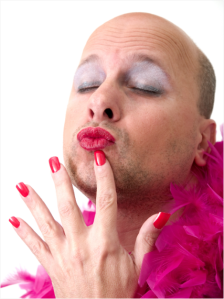 stereotypes and those who are able to gain capital must constantly keep up the “homosexual performance” in order for their capital to be maintained, thus trapping them in a chronic loop where they can only wind up failing.
stereotypes and those who are able to gain capital must constantly keep up the “homosexual performance” in order for their capital to be maintained, thus trapping them in a chronic loop where they can only wind up failing.
The queer community is just as diverse as the heterosexual community, if not even more, but the danger of this stereotype especially is that it is so prevalent and so enduring and, while there are actual people who are like this and there is nothing wrong with them, it is when this becomes the only image that many in cultural marketplace see when it becomes a problem. This stereotype portrays that queer people must constantly maintain a show to the heteronormative world that shows that they are who they say they are and those who do not, those who are merely part of the diversity of the community, find themselves without capital because they do not conform to what others believe they should act like.
A perfect, recent example of the treatment of queer individuals is that of the 2012 VH1 Divas. The commercials all show the numerous great female performers like Miley Cyrus, Beyonce, Kelly Clarkson and Jordan Sparks and who is the one they get to host the event, Adam Lambert, the gay guy in the music industry. And, yes, other males did perform during the event, but they were never even mentioned in the promotion of the event. An event which celebrates women in the music industry coming together for a good cause is MC’ed by a “woman”, as well, that “woman” being Adam Lambert.
Works Cited:
-Cullen, Jack. The gay one from Glee – positive role model or dangerous cliche? The Guardian. 15 March 2011. Retrieved 21 Nov. 2012. Online. http://www.guardian.co.uk/tv-and-radio/tvandradioblog/2011/mar/15/kurt-hummel-glee-gay
-Evans, Victor D. Curved TV: The Impact of Televisual Images on Gay Youth. American Communication Journal. 2007. Retrieved 22 Nov. 2012. Online. http://ac-journal.org/journal/2007/Fall/5CurvedTV.pdf
-Martin, Alfred L. Jr. Dude Looks Like a Lady: Examining Kurt Hummel’s Gender Construction on ‘Glee’. Popmatters.com. 16 August 2010. Retrieved 19 Nov. 2012. http://www.popmatters.com/pm/feature/127289-dude-looks-like-a-lady/
Queer People as Corrupters
One of the more destructive of the portrayals of queer people is one that states that queer people are corruptors and that they are destructive to society. This is a rather older belief, dating back to the early 20th century and coming to prominence in the Cold War-era, but it is still used on occasion, especially within the gay marriage debate, stating that, if gay marriage is passed, then it will destroy the institution of marriage. Why would giving someone the right to marry destroy marriage for everyone else if they were not considered corruptors of “normal”, “proper” society.
This is not a portrayal that queer people necessarily step into on their own, but it is something that they are often focused into unwittingly, adding to the horror of this stereotype. This role may be a negative one, but it does still bring with it symbolic capital, much like someone who commits a public crime gains notoriety. It is because of the negativity that the public feel towards figures like these that they loose much of the symbolic capital that they gain from these roles; yes, they are still recognized, but they almost all other benefits.
A modern example of this portrayal in popular media is the character of Mr. Slave in South Park. Mr. Slave is actually intended to be an anti-sympathetic character, though he reveals himself to be a kind and caring individual, actually at one point stating that they should not cheer for him and glorify him because he is “a filthy whore.” Mr. Slave (or Teacher’s Ass as Mr. Garrison called him), in most situations, is someone who is meant to make the audience uncomfortable because he is constantly being exposed to the children of South Park while doing any number of inappropriate things, including rubbing his groin at a Jonas Brothers concert with children all around, never using better judgement and stopping as if he just cannot help himself, like he has no self-control. He is constantly presented as if to invite parents to look at him as an extremely negative influence, which he even admits openly, as if to show parents what happens when they allow their child to be around gay men. His voice is one that is only heard in the rarest of circumstances, aside from his catchphrase, “Oh, Jesus Christ!”, and, in the end, he merely becomes a caricature, even when he is goes through something positive, like his wedding, he is satirized, wearing a white wedding dress and showing what will actually happen if gay men are allowed to be married. He lacks a clear, individual voice and is not given much capital outside of affairs of a sexual or feminine nature.
An example involving lesbians is a little more difficult to find because, as a political character in South Park stated, “Well, who cares about f***ing lesbians?”, but one common trope in popular culture is the figure of the lesbian vampire and, in many ways, it is far more destructive because at least characters like Mr. Slave are human, but the image of the lesbian vampire strips away the humanity and turns them into monster who not only corrupt the nice straight characters, but also feed on them.
The portrayal of queer people as the corruptors, in a way, gives capital to society rather than the people it represents because the stereotype muffles their voice and invites society to voice their beliefs and lay their fears onto these characters.
These portrayals and stereotypes have had profound effects on the way that queer people have been treated. Germany in the 1930s is a graphic example of this with the changes made to Paragraph 175 within the crime code:
§ 175 Indecency between men (1935)
Section I: A man who commits indecency with another man, or engages as the passive partner to be misused indecently will be punished by imprisonment.
These…changes to paragraph 175 significantly expanded the reach of the law, effectively criminalizing any form of affection between men. It prosecuted men for kissing, mutual masturbation, love-letters or even sordid glances. In one recorded instance, a soldier on leave was arrested for merely brushing up against another man, who was an undercover SS sergeant (Amir Persistence 4).
Now, this may seem like its been regulated to the halls of history, but these sorts of beliefs are still prevalent through the world, including places like contemporary Poland where right-wing politicians and “representatives of Catholic clergy [will] argue against allowing equality marches, calling them a ‘threat to public morality’ and an effort to ‘promote homosexuality,’ almost inevitably referring to the obscenity seen in the Berlin Love Parades” and “‘ordinary people’ featured by the media [will] express their ‘instinctive’ hostility to ‘perversion’ or — in the moderate version of the ritual — claim that they had nothing against gay people as long as they did not have to see them in public” (Graff para. 3).
Finally, if this doesn’t convince some, watch the video below and learn about what was called “The Lavender Scare.”
Works Cited”
– Graff, Agnieszka. Looking at Pictures of Gay Men: Political Uses of Homophobia in Contemporary Poland. PubicCulture.org. 2009. Retrieved 20 Nov. 2012. Online.
-Amir, Adam A. The Persistence of Paragraph 175: Nazi-style Justice in Post-War Germany.4. May 2010. Retrieved 20 Nov. 2012.
Terms and Explanations
Because I will be referring to many various terms and concepts which may be confusing and some may find quite complex, I’ll be providing a list on the various terms I’ll be using so that, at any time, a reader can look back up if they become confused or need clarification.
The term, cultural capital, was created by the sociological thinker, Pierre Bourdieu, as a way of explained how and why people interact the way they do. Bourdieu defines cultural capital as “accumulated labor…which, when appropriated on a private, i.e., exclusive, basis by agents or groups of agents, enables them to appropriate social energy in the form of reified or living labor…the principle underlying the immanent regularities of the social world. It is what makes the games of society-not least, the economic game-something other than simple games of chance offering at every moment the possibility of a miracle” (Capital 46).
Now, if this confuses you, do not worry, one of the biggest criticisms of Bourdieu is his lack of clarity with his concepts. If you don’t understand what he is saying, some of the brightest thinkers in the world have had problems with Bourdieu. An easy way of think about Bourdieu’s ideas is to think about all social inactions as a vast marketplace, the cultural marketplace. In this market place, there is no money, only what Bourdieu calls cultural capital, which can be described as a sort of influence or authority. Every person, or agent, in society has a little bit of cultural capital, but it is possible to gain more and the more cultural capital someone has, the more their opinions and beliefs matter, the legitimacy and credibility they have and the more people will listen to what they have to say. Cultural capital provides structure to social situations and informs our decisions in social exchanges, for example, if you go to a doctor’s office and learn that you need to start eating better, you’ll listen to a doctor more than a nurse because a doctor has more education and more skill, which gives them more cultural capital.
Bourdieu names identifies that there are several different types of cultural capital, each of which come from different sources. One is known as known as “the embodied state” which relates to money and wealth, as well as all things inherited like linguistic skills, and, while some say that queer people have a lot of money on political campaigning, known as “Pink Money”, I have never bought that idea because then they would actually be a demographic that politicians would cater to refer than just a passing consideration. Besides, if they really had the money that the term implies, full marriage rights would have been passed years ago. But, perhaps, this category does relate to the queer community, then obviously something else is in the way. That is where the other categories come in.
The next form of cultural capital, one which is key to any group that faces stereotyping is what Bourdieu calls cultural capital’s “objectified state” which he states is “objectified in material objects and media, such as writings, paintings, monuments, instruments, etc., is transmissible in its materiality. A collection of paintings, for example, can be transmitted as well as economic capital (if not better, because the capital transfer is more disguised)” (Capital 50).
Cultural capital in its objectified state, according to Bourdieu, is actually more powerful than its embodied state because it is more transmissible and is something that is produced and created by the agents instead of merely something that is possessed. The objectified state of cultural capital is something that is key to queer people because this is the power that their narratives give to them and it is this power that allows them to be able to break the screens and the stereotypes which define them, but this is the power that is often exchanged for another type of capital in order for others to listen.
Symbolic capital is the type of capital which is very present nowadays and one which queer people must trade in their objectified capital in order to gain. Bourdieu defines it as “economic or political capital that is disavowed, mis-re-cognised and thereby recognised, hence legitimate, a ‘credit’ which, under certain conditions, and always in the long run, guarantees ‘economic’ profits” (Svendsen Expanded Concept 4). Symbolic capital can be explained through the saying “everyone has their fifteen-minutes of fame.” Symbolic capital is the type of capital that comes from recognition and from the public noticing you, like the Warhol effect. Symbolic capital is something that allows queer voices to be heard, but, in order to receive symbolic capital, queer people must conform to common portrayals of them in the media and popular culture and this causes them to loose their ability to have their stories heard because they often do not fit with the commonly held beliefs and conceptions.
Works Cited:
-Svendsen, Gunnar L. H. Bourdieu’s Expanded Concepts of Capital: Its Potential for Application with a Focus on Social Capital. 4. The Danish Institute of Border Region Studies. October 2001. Retrieved 19 Nov. 2012. Online.
-Bourdieu, Pierre. “Forms of Capital.” Handbook of Theory of Research for the Sociology of Education. 46, 50. Ed. J. E. Richardson. Greenwood Press: 1986. Online.
Introduction
“You feel like you’re split down the middle. Your right arm wants to unbutton your shirt while your left arm is trying to keep your shirt on. You’re torn between wanting to kill everyone in the room, or buying ‘em all another round of drinks” (Howe Spider 245).
This is a quote from Leanne Howe’s short story called “An American in New York.” It’s a story about a half-white, half-First Nations woman going to New York in the late 1980s, I believe. These words are her thoughts on being a “half-breed” as she calls herself, but these words have caught be and stuck in my head since I first heard them in my first year English class.
I suppose the reason for this is not because I’m bi-racial (though I am gay), but because I’ve been an outsider all my live, whether it be in school or at home, I’ve always been the black sheep or, as I once stated in a elementary school assignment, “I feel both invisible and like a raven in a flock of pigeons, at the same time”, to which my parents responded, “Oh, everybody feels like that sometimes.” Is it believable that that didn’t make me feel any better?
Anyway, I told my seminar group how much this quote related to be and about being an outsider and, once in the lecture hall, the professor walked up to me and asked, “In what ways are you an outsider?”
I responded by saying that I had always felt different than everyone else and generally out of place.
To which she responded by saying, “Oh, so it’s just self-imposed, then?” and walked away.
This almost through me for a loop and I imagine that a lot of queer people have been told something similar as of recently because of the fact that queer identity has been something of a hot-button issue and has been a major topic of decision for the last little while, especially because of the recent presidential election.
I’m sure that there are many queer people have heard this sort of line at some point, “What’s the big deal? Isn’t the whole ‘gay rights’-thing over with now? I mean, you have the right to marry!”
The truth is that there are still many problems and many issues that still need to be addressed, marriage is merely the largest and most critical right that is not given to queer people (when was the last time anyone heard about someone refusing to marry an Asian couple? Or a black woman not being allowed to see her husband in the hospital?)
One of the most key problems that any minority group must deal with is their portrayal in the media and in popular culture. This portrayal is an especially important problem because it effects the amount and the type of cultural capital that queer people are given within the cultural marketplace. This effects the influence that the community has and thereby limits the narratives of the community that will be heard. This inability to have its stories heard stops the truth from being exposed to the general public and this causes the queer community to be considered illegitimate and be robbed of power which other groups may have.
These limits often take the form of different stereotypes and “archetypal” queer characters that are shown in popular media, these function as the greatest limiter of capital because they form a sort of terministic screen, which can be described as “word filters” which is constructed of ideologies and effects how something is perceived, blinding them to certain images or facts and replacing them with one which support the ideologies that make the screen. These screens limit the ability for queer people to make their stories know and to have them taken serious and, if a queer person wants to be able to have their narrative heard, then they must confront to the stereotypes that are placed on them, but this merely gives them one type of capital in exchange for another and they end up in a similar place as before. The quote by Leanne Howe illustrates the paradox queer people in this sort of situation, they want to have their narrative heard and so they want to play to the media figures, but, at the same time, they hate those portrayals and so they want to fight against these images, but then their narratives go unheard.
For those who are still reading, but aren’t convinced that the whole “gay rights-thing” is important, I walked by this sign when I was leaving an evening class one night.
The sign is for a Blood Donor Clinic and tells the reader that if they give blood, then they’re a hero, obviously. But, it is important to note that there is a clause on the information sheet that they give you when you give blood that if you’re a male and you’ve ever had intercourse with another male, then you are forbidden from ever giving blood. Gay people cannot be heroes, it appears.
Works Cited:
-Howe, Leanne. “An American in New York.” Spider Women’s Granddaughters. 245-255. New York: Fawcett Columbine, 1989. Print.
-Humphreys, Sara. “The Harlem Renaissance and American Lifewriting.” Trent in Oshawa lecture. Trent University. 19Nov. 2012. Performance.
